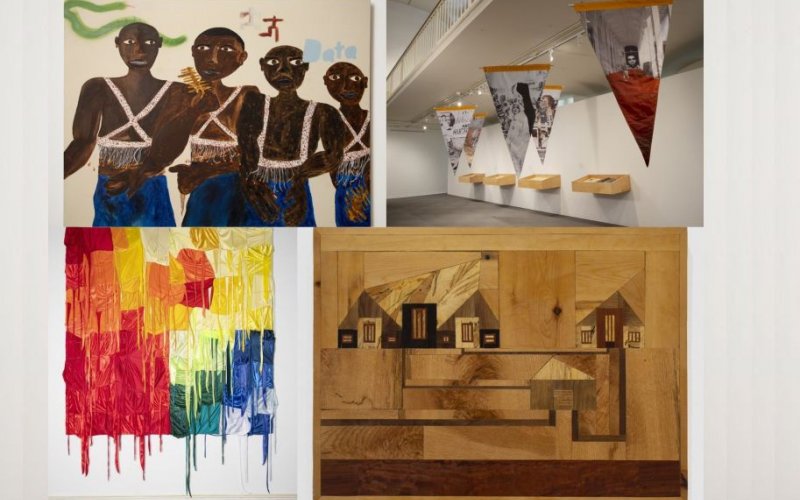Museum welcomes campus visitors with two new exhibitions

ALBANY, N.Y. (Feb. 2, 2021) — The University Art Museum has two new exhibitions for the Spring Semester, and is open to UAlbany students, faculty and staff for in-person visits between noon and 3 p.m. on Wednesdays, Thursdays and Fridays through the Museum’s online reservation system. In-person tours are also available upon request.
The new exhibitions explore elements of justice and idealism with works by contemporary artists.
“Torch ’72/2020” is a commissioned project by artist Shane Aslan Selzer that reactivates UAlbany’s 1972 Torch yearbook, which was edited by then student and renowned AIDS activist, Ron Simmons.
The Social Action Archive Committee (SAAC), formed by the artist in 2015, interviewed current student leaders on campus using the 1972 yearbook as a visual prompt to speak about the trajectory and lineage of intersectional justice efforts on the UAlbany campus. These discussions center on Ron Simmons’ work as an early leader in intersectional social justice fights and provide an important lineage for current students who continue to work with urgency now.
Selzer’s interest in the Torch ’72 yearbook is also personal—her parents graduated from UAlbany in 1972. The yearbook shaped how Selzer thinks about image and text archives, juxtapositions and framing. In speaking of discovering the yearbook as a child, Selzer says, “I had never seen anything like it. I looked at it late at night, for years and showed it to any friends who would show interest. It was a radical document I had stumbled upon that felt like a guide to living.”
“i.de.al.is.tic” brings together the work of artists Anthony Akinbola, Sean Desiree and Marcus Leslie Singleton. The exhibition , curated by Michael Mosby, explores each artist’s relationship to the concept of idealism — the unrealistic aim for perfection.
Singleton deals with the everyday, while Akinbola abstracts the concept of a Black identity and Desiree objectively describes the inherent beauty in public housing units. In each of these artists' practices there is an acceptance of imperfection, and through this resolve a true picture of a complex Black narrative emerges.
“We all yearn for perfection. Perhaps this desire is spawn from the failures of our day to day. We seek refuge from this desire in people, places and things,” Mosby said. “However only in art is there a symbiosis between the idealistic and its shadow.”
As a first-generation Nigerian American, Anthony Akinbola works to reconcile the three cultures that make up his identity — “The African,” “The American” and “The Negro" — and explore how stereotypical notions of race, identity and culture are embedded into current society.
Marcus Leslie Singleton’s paintings reflect reality, depicting moments of the strange world we are currently experiencing. Filtered through his own experiences, he seeks to expand on what this time means to people, to encourage introspection on who we all are and what each of us believe.
Using found wood from pallets, demolished buildings and discarded scraps, Sean Desiree creates aerial views of public housing units in upstate New York through intricate wood inlay and geometric patterning. Proceeds from the sale of these works fund grants for local artists and makers living in upstate public housing.
Support for the University Art Museum exhibitions and programs is provided by The Andy Warhol Foundation for the Visual Arts, the Office of the President, Office of the Provost, and The University at Albany Foundation.
Museum Hours
Access is currently limited to the campus community, by appointment only, due to COVID-19. You can reserve a one-hour time slot between noon and 3 p.m. Wednesday through Friday, or arrange for a tour of the Museum Monday through Friday via the Museum’s online reservation system. The museum is not open to the general public at this time because of COVID-19 protocols.
For the most up-to-date information on hours and visitor guidelines, visit the Museum website or call 518-442-4035.




